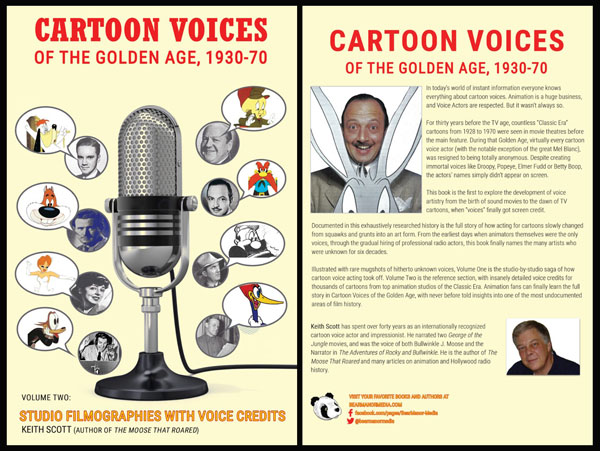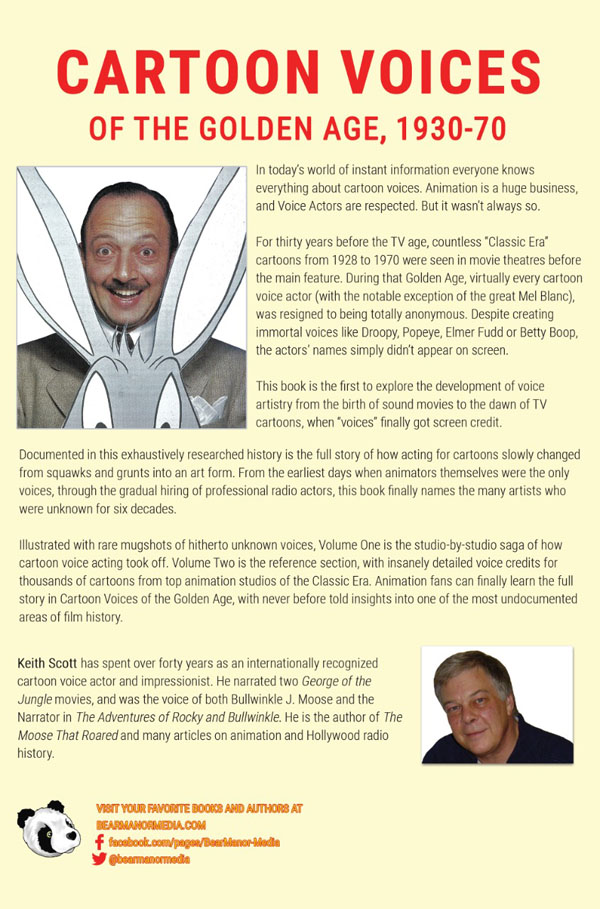
In fact, Cartoon Voices Of The Golden Age (1930-1970) was such a big project, I had to break it into two volumes. Part 1: The Pioneers of Animation Acting and Part 2: Studio Filmographies With Voice Credits. Bear Manor Media will release the two volumes officially on September 20th. It should also be listed on Amazon very soon.
After such a long wait I’m hoping it accurately answers a lot of your often asked questions. I’m also hoping it clears up a lot of bad facts that are out there… IMDb and Wikipedia still have many wrong names being bandied about in cyberspace, and people tend to accept the inaccurate stuff. And for some reason they are then very loath to change their opinion.
I’m hoping the book will bridge a long neglected gap in film history. It’s not only a history of how the movie cartoon industry grew, but also a mini-history of related aspects like the business itself, its workaday aspects and power plays, radio artists back in the day, recording sessions, and the careers of animation directors. A ton of theatrical cartoons get mentioned along the forty year span, and I tried to show a kind of catholic sympathy for a lot of the dross as well as praising the true high points of the medium.
Many fans have strong loves and hates, but I’m a fan who has been part of the industry I write about… I’ve done cartoon voices from way back in 1972 and all the way up to this year… so I know why some cartoons were duds, I know about ideas that end up being compromised, I’ve seen creative interference – both good and awful – up close for decades. I have worked with many animation actors on hundreds of cartoons and I know what goes on. My own tastes are also pretty catholic and I can enjoy a lot of B-grade stuff that often gets rubbished. Unlike a lot of cartoon specialists I can love vintage Disney equally along with vintage Warner Bros. and the Fleischer films. But having said that, there is a mild critical tone in the narrative for those who want to seek it out.
Many times I had to catch myself and explain things to the reader that I had at first assumed were commonly known. What was difficult was the sheer amount of material I had to cover, connect and explain concisely, so as not to turn the thing into a multi-volume encyclopedia. There are so many overlapping stories of people who end up in more than one of the studio chapters. Not just the voice artists: the business always attracted nervously creative people among the cartoon artists and gag writers, people who often needed constant change to maintain their spark. There was also constant cross-pollinating of ideas, influences and rivalries that resulted in bruised feelings and accusations of creative theft.
Mel Blanc is highly prominent throughout much of the story. Even a master voice artist like Paul Frees told me that he regarded Mel as the undisputed king of cartoon voices. And that he was, a brilliant actor for the cartoon medium, which is one reason why Jack Warner snapped him up in 1941. And also a reason why the Warner Bros. chapter is the book’s longest. Aside from Mel Blanc, who is hugely important – even iconic to use that overused word – I wanted to cover the other important names of the 1930s and 40s like Pinto Colvig (aka Goofy), who also pops up in virtually every chapter. The book is not biographical except in certain instances where I had to place names like Billy Bletcher (the Big Bad Wolf) and Bill Thompson (Droopy) in context with the timeframe. Then it becomes easy to see why they got so much work. A lot of it went beyond their native talent. If they were proven to be reliable and efficient voice actors, well it’s the old saying: work begats more work.
The lack of screen credit for some thirty years was the truly motivating reason for me to undertake the decades of research and to envision this book when it was just a vague concept. Throughout the writing of the book I was always aware I had to be super diligent in mentioning the few rare times screen credit actually occurred (aside from Mel of course, although he had seven anonymous years himself). I really had to go back in time and learn a lot of what made the business operate the way it did. With the actual voice artists I was very fortunate because I had a grounding of being a crazy lover of old films and American radio dramas for many years before I got into just the cartoon topic. Since childhood I was into old character actors, vintage movies and bit players because I somehow knew I was heading into a show biz life. So I knew many of the names of people who I eventually learned did cartoon acting. Slowly it all made sense, like a crazy jigsaw puzzle coming together. It’s all about connections in show business.
The New York studios remain my biggest regret. Very little, in fact zero, paperwork on voices and recording dates seems to have survived for Paramount’s Famous Studio and the Terrytoons, although I am confident that partial records exist in musty archives somewhere. In early 2020 I had planned a visit to see if I could dredge up some stuff at NY’s famous show biz library (Billy Rose Collection, in Lincoln Center), but Covid hit with a large thud, and the pandemic put paid to any travel research I wanted to undertake for the last two and a half years. And don’t forget, I live far, far away in Australia. I’m not complaining, but the facts are that my work dried up dramatically, travel was unaffordable and also not allowed… all sorts of things concentrated my mind to finish up the book that I had, and damn the torpedoes! Otherwise it would still be only half finished and possibly published in another decade… no way. There’s always the chance of an expanded edition down the track, so I remain positive.

Bill Scott
Is there still more research before this topic is covered? Will there be a follow-up book? Maybe the research will change with advances in the online world…search engines like Newspapers.com and online library research is becoming do-able. This book is built fact by fact on hundreds of tiny pieces of information that form that giant jigsaw puzzle of connections, and some lost names might conceivably pop up to make the story even more complete. Don’t forget there are still those ten Voice mysteries listed in the back of the book that are calling out to be solved! I call on you young and energetic cartoon history researchers to feed me any results you find in this never-ending saga!
I hope you’ll consider purchasing the volumes… I think you’ll like it, and I think it will answer a lot of your questions.

The back and front covers for Part 2.
Click to read enlarged image of the Part 2 back cover
(By the way, the giant set of filmographies is really the part of the project I wanted to complete as a tribute to my major research associate, Hames Ware, who died back in 2018. He was a highly important ally in my first ten years of research.)



